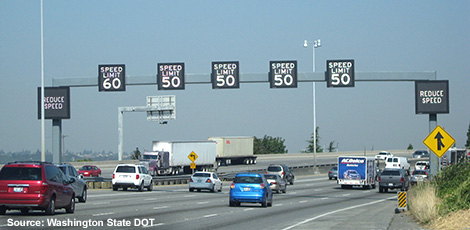
Integrating Operations into Planning and Programming
The Federal Highway Administration (FHWA) and Federal Transit Administration (FTA) promote the use of an objectives-driven, performance-based approach to planning for operations as an effective way to integrate operations into planning and programming.
Key topics in this area are:
An Objectives-Driven, Performance-Based Approach
This approach focuses on both short-term and long-term system performance, using established system performance measures rather than simply focusing on implementation of projects as a measure of success. It can be applied to both metropolitan and statewide transportation planning processes.
The approach emphasizes consensus and collaboration across modes and jurisdictions and between planners and operators to help ensure that regional transportation investment decisions reflect the consideration of available strategies and approaches to meet a regionkes transportation goals and objectives.
An objectives-driven, performance-based approach to planning for operations is based on the concept that "what gets measured gets managed." Investments are made with a focus on their contribution to meeting regionally agreed-upon objectives. By implementing this approach, resources are allocated more effectively to meet performance objectives, resulting in improved transportation system performance.
To assist agencies with further understanding and applying Planning for TSMO principles, three virtual courses are available through the National Highway Institute. For more information on these courses, see this brochure.
OTHER RESOURCES
- Integrating Travel Time Reliability into Transportation System Management: Final Technical Memorandum (HTML, PDF 10MB)
This report entitled "Integrating Reliability into Transportation System Management" documents a Federal Highway Administration (FHWA) project led by the Office of Operations to address the gaps between planning and operations. Its intent was to evolve the state of the practice by building a methodology supported by the data and analysis tools developed under the SHRP2 program. The project was motivated by the need to connect system-level, goal and objective-setting in the transportation planning process and operations planning that occurs among operators. Long-range transportation planning is typically not linked to detailed, tactical operations decisions made at the corridor or network level. A primary objective of this project was to develop and demonstrate a framework or methodology for integrating travel time reliability concepts and analysis in systems management, operations, systems planning, and programming. The project also demonstrated how this framework can be used to connect planning-level reliability goals and objectives to operational objectives and transportation systems management and operations (TSMO) strategies and tactics. - PlanWorks: A Web Resource for Collaborative Decisionmaking
-
Illustrative Deployment Packages of TSMO Strategies in Corridors and Subareas: A Primer (HTML, PDF 11.5MB)
This primer showcases six illustrative packages of TSMO strategy deployments with varied geographic, social, and institutional contexts. The primer will enable planners and transportation engineers to think beyond deploying TSMO on a project-by-project basis to defining and advancing a "package" of project deployments, institutional advancements, and programs. - Planning for Transportation Systems Management and Operations Within Corridors: A Desk Reference (HTML, PDF 8.1MB) - This Desk Reference is designed to equip State, regional, and local transportation operations and planning professionals with the knowledge and tools necessary to effectively plan for and implement transportation systems management and operations (TSMO) within a corridor. (Publication Number: FHWA-HOP-16-037, September 2016).
- Advancing Transportation Systems Management and Operations Through Scenario Planning (HTML, PDF 1.2MB) - The intent of this primer is to inform planners, operators, and other transportation systems management and operations (TSMO) partners on the potential use of scenario planning to advance TSMO. (Publication Number: FHWA-HOP-16-016, October 2015).
- Advancing Transportation Systems Management and Operations within Corridors and Subareas: Web-Based Informational Session (HTML, PDF 336 KB) - This is a web-based instructional session on the applications of a performance-based, integrated, and multimodal approach to planning for transportation systems management and operations, or TSMO, within corridors or subareas. The session includes video presentations by workshop instructors and practitioners, demonstrations, narrated slides, and two case studies that can be used as group or individual exercises.
- The How: Case Studies Advancing Planning for Operations
-
- Capital District Transportation Committee Albany, New York, Case Study (HTML, PDF 323KB) - Placing the Congestion Management Process in the Context of Metropolitan Transportation Planning Goals and Objectives
- Delaware Valley Regional Planning Commission Philadelphia Metropolitan Region, Case Study (HTML, PDF 305KB) - Planning for Congestion Management and Tracking Progress
- The Denver Region Traffic Signal System Improvement Program Case Study (HTML, PDF 324KB) - Planning for Management and Operations (Denver, Colorado area)
- Metropolitan Transportation Commission San Francisco Bay Area Case Study (HTML, PDF 455KB) - Developing Regional Objectives and Performance Measures to Improve System Operations (San Francisco Bay Area, California)
- Pima Association of Governments Case Study (HTML, PDF 402KB) - Regional Concept for Transportation Operations Fosters Planning For Operations in the Tucson Metropolitan Area
- Wilmington Area Planning Council New Castle County, Delaware and Cecil County, Maryland Case Study (HTML, PDF 340KB) - A Performance-Based Approach to Integrating Congestion Management into the Metropolitan Planning Process (Newark, Delaware area)
- Statewide Opportunities for Integrating Operations, Safety and Multimodal Planning: A Reference Manual (HTML, PDF 1.8MB)
- The Use of Operations Objectives and Performance Measures in Private and Public Organizations (HTML, PDF 82KB)

